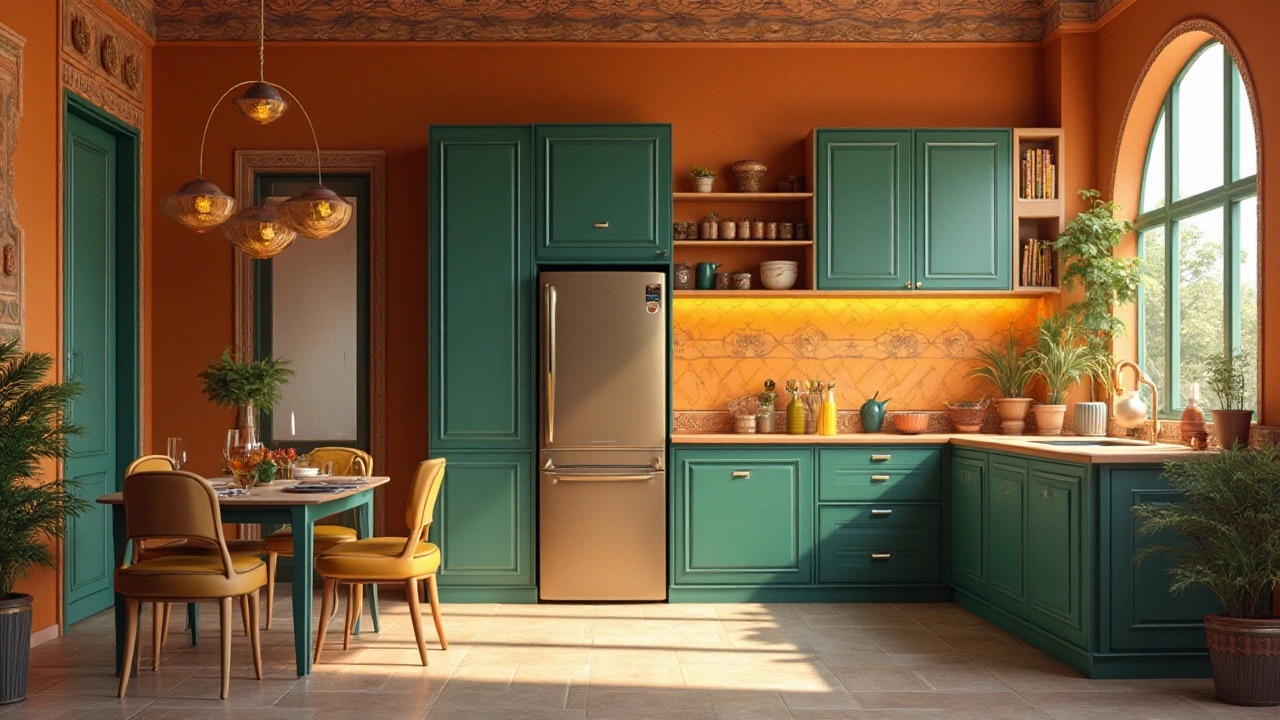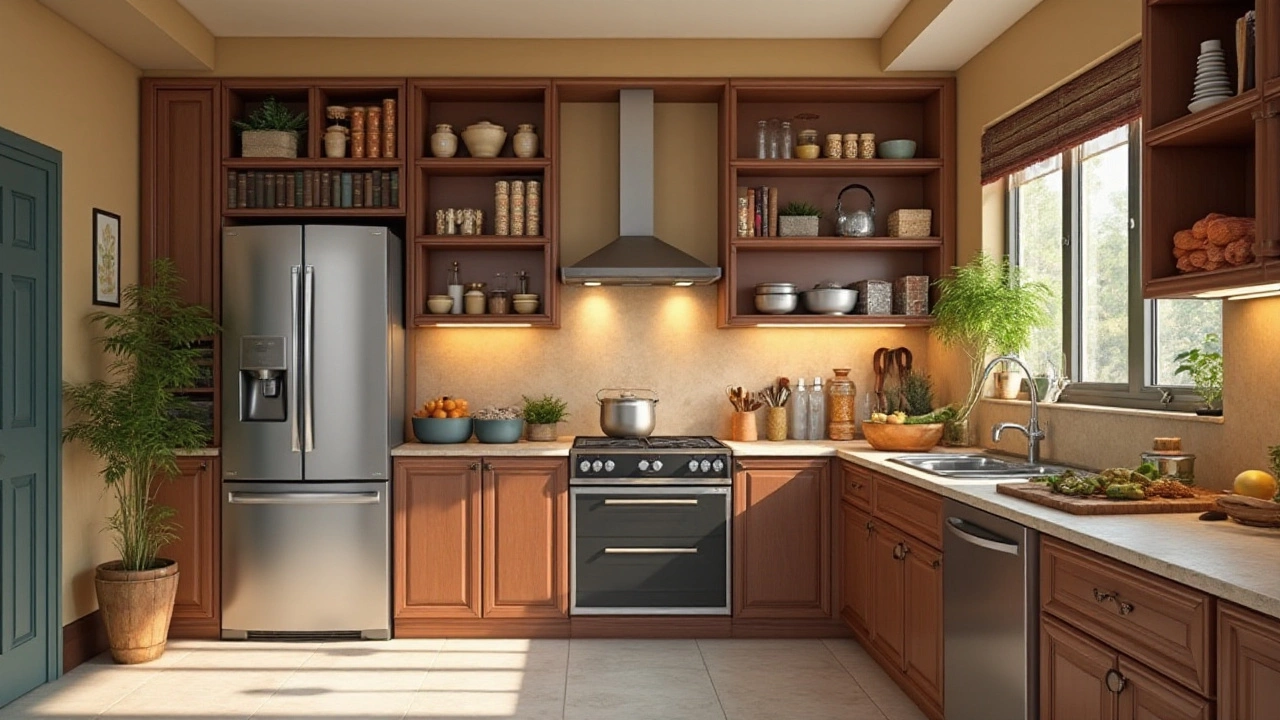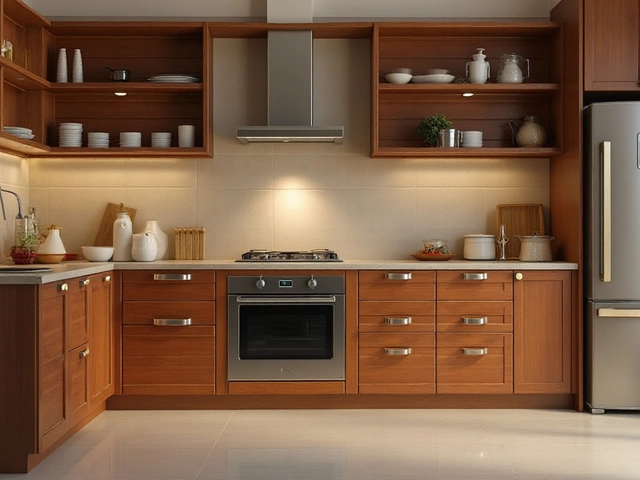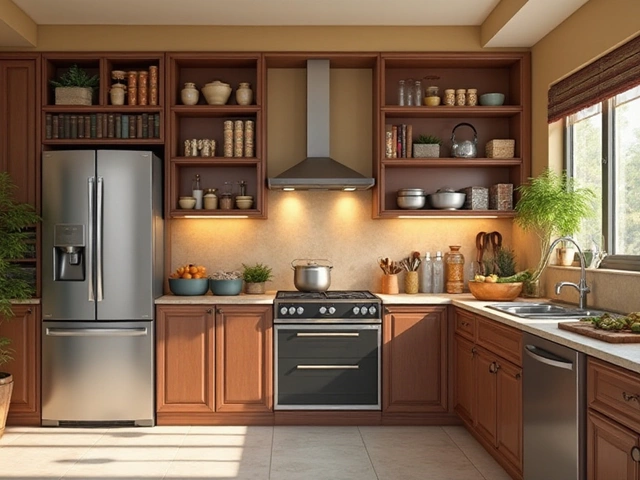The kitchen is more than just a space for cooking; it's where families gather and memories are made. Designing this space is crucial, and where you place major appliances like your refrigerator can make or break its functionality.
Putting a refrigerator in the wrong spot can lead to inconvenient use, cramped spaces, and even potential damage to the appliance itself. Whether you're redesigning your kitchen or planning a new one, understanding the best and worst places for your fridge can save you time, money, and frustration in the long run.
Stay with us as we unravel some important tips and tricks to ensure your refrigerator finds its perfect spot in your kitchen.
- Importance of Layout in Kitchen Design
- Common Mistakes in Refrigerator Placement
- Factors to Consider for Optimal Fridge Placement
- Creative Solutions for Limited Spaces
- Integrating the Fridge into Your Kitchen Aesthetics
Importance of Layout in Kitchen Design
When it comes to designing the heart of the home, the layout of the kitchen plays a pivotal role in determining the efficiency, functionality, and aesthetics of the space. The kitchen is not just a room; it's a dynamic space where culinary magic happens, where homeowners express creativity, and where the functionality of design can significantly impact daily routines. A well-thought-out kitchen layout considers the spatial needs and movement patterns of its users, ensuring that the kitchen is both practical and comfortable. The existence of a well-planned kitchen layout can transform cooking from a chore into a delightful activity. By strategically placing key appliances, such as the refrigerator, you facilitate a smooth workflow that is often conceptualized in the classic 'kitchen triangle' model—linking the stove, sink, and refrigerator efficiently.
In today’s world, the importance of an effective kitchen layout has been emphasized in various design philosophies. Good kitchen design takes into account the need for ample storage, efficient movement, and the ease of accessing the tools and ingredients needed for meal preparation. Keeping the refrigerator in the right spot allows you to maintain the flow of the kitchen's 'golden triangle', without creating unnecessary obstacles that could disrupt the cooking process or hamper social interactions. According to well-regarded architect and designer, Frank Lloyd Wright, 'Space is the breath of art,' and this couldn’t be more applicable than in kitchen design, where understanding how people use space can enhance both the beauty and functionality of your home.
The design must also consider modern lifestyle demands, such as the need to integrate space for multiple cooking styles, family interactions, and potentially dual cooking zones for homes where cooking is a collaborative effort. A properly positioned refrigerator contributes massively to the kitchen's efficiency, offering immediate access without encroaching on essential cooking areas or seating spaces. It's crucial to ensure that there is adequate task lighting in these zones, as well as unobstructed pathways not just for the chef, but also for family members passing through or kids running around.
When thinking about where not to place your refrigerator, you should also consider the room's visual aspects. An ill-placed fridge can dwarf significant focal points of your kitchen, such as eye-catching backsplashes or stunning countertops. If your kitchen includes a central island, care must be taken to avoid crowding this multipurpose space. The best layouts manage to conceal functional elements such as a refrigerator in a way that they support rather than distract from the kitchen's overall aesthetic.
Statistics from recent studies show that a poor kitchen layout can increase meal preparation time by as much as 30%, adding unnecessary stress to our busy lives. Incorporating thoughtful design can dramatically improve not just the efficiency of the kitchen, but also the enjoyment derived from time spent there. Below is a quick look at an interesting table regarding kitchen layout preferences:
| Layout Type | Percentage of Use |
|---|---|
| L-Shape | 40% |
| U-Shape | 30% |
| Galley | 20% |
| Peninsula | 10% |
In summary, getting the right layout can make your kitchen a joyful space that seamlessly combines ergonomics with aesthetic appeal. The refrigerator is a heavyweight player in this scene, and its strategic placement can either complement or compromise your design ambitions.
Common Mistakes in Refrigerator Placement
One of the most commonly overlooked aspects of kitchen design is the placement of the refrigerator. A poor choice here can lead to a series of problems that compromise the utility and comfort of your kitchen. One common mistake is placing the fridge too far from the 'kitchen triangle'—an ergonomic concept connecting the sink, stove, and refrigerator. The goal is to reduce unnecessary movements, and placing your fridge too far out of this flow can make cooking cumbersome. Another problem is placing it next to a heat source. Refrigerators require breathing room to function efficiently, and placing them next to your oven or stove can force them to work harder to maintain their temperature, leading to increased energy consumption and potentially reducing the lifespan of the appliance.
"The right kitchen layout can add space, make use more efficient, and promote a healthier lifestyle. Taking time to properly arrange your appliances is crucial," advises Anna Smith, a leading kitchen design specialist.
Refrigerator placement near doors is another pitfall. While it might seem convenient, especially for those who need quick grab-and-go access, frequent door opening causes temperature fluctuations, putting strain on the fridge and raising your energy bills. Additionally, large appliances might block doorways or interrupt the natural flow through the kitchen. Avoid cramming the fridge into a corner or against a wall where it lacks ventilation. This configuration doesn't just lead to overheating issues but also makes accessing items inside the fridge inconvenient. Finally, failing to account for swing space for fridge doors is a more practical concern. It might be easy to design an impressive-looking kitchen, but if opening your refrigerator requires acrobatics or moves dishes off countertops, you've got a problem.
According to recent statistics, households can save up to 10% on energy bills by optimizing their kitchen layouts. This reinforces the importance of well-considered refrigerator placement. When redesigning your kitchen or when selecting a spot for your new fridge, ensure that you avoid these common pitfalls. By taking such an approach, you'll enjoy a more efficient, comfortable, and cost-effective kitchen experience that truly meets your needs. A thoughtfully placed fridge is integral to a functional kitchen, so take the time to plan its perfect location.

Factors to Consider for Optimal Fridge Placement
Designing a kitchen that not only looks good but also functions efficiently is an intricate balancing act, especially when choosing where to place a refrigerator. Selecting the perfect spot for your fridge involves considering the convenience of day-to-day activities, the flow of foot traffic, and even the overall kitchen design. One of the primary considerations is proximity to the kitchen triangle—an age-old concept which suggests that the sink, stove, and fridge should form a triangle, ensuring that everything you need is within easy reach as you prepare meals. This concept helps streamline workflow and minimizes unnecessary movement around the kitchen.
In addition to the kitchen triangle, it's essential to think about the available electrical outlets and plumbing. Many modern refrigerators require a water line for ice and water dispensers, so access to plumbing can play a huge role in deciding where your fridge should go. Similarly, it is crucial to keep your electrical needs in mind, ensuring that your fridge's dedicated outlet is conveniently located. This might mean bringing in a professional to move or add outlets during the kitchen design process.
Lighting is another factor to consider when placing your fridge. Refrigerators placed in well-lit areas are not only more visually appealing but also allow you to easily see and access food. Avoid placing your fridge in a window's direct sunlight, as natural light can heat up the appliance, causing it to work harder and shortening its lifespan. By keeping the fridge away from heat sources, such as ovens or dishwashers, you can prevent unnecessary energy consumption. If positioned near heat sources, emissions from these appliances can compromise the efficiency of your fridge, leading to higher utility bills.
Space and clearance should also be a focal point when deciding on fridge placement. Ensure there is adequate space for door clearance, allowing for a full swing without bumping into walls, cabinets, or other appliances. A good rule of thumb is to have at least a two-inch buffer around your fridge to guarantee adequate ventilation and prevent overheating, which can cause unintended damage. Don't forget to factor in how often you access your fridge—placing it too far from main workspaces can become an everyday inconvenience.
According to Sarah Watson, a well-respected interior designer, "A well-thought-out kitchen layout can increase a home's value by as much as 15%. Choosing the right appliance placement, such as your refrigerator, is critical to optimizing space and efficiency."
Lastly, the style and design of your kitchen can heavily influence fridge placement. For those pursuing a sleek, modern look, consider integrating your fridge into cabinetry for a seamless appearance. On the other hand, if you're dealing with limited space, you might need to get creative with your placement, even considering unconventional but surprisingly effective solutions like placing your fridge in a pantry or hallway alcove. This tactic can open up options and preserve precious kitchen square footage while maintaining accessibility.
Creative Solutions for Limited Spaces
Kitchen space is the ultimate luxury, yet many of us find ourselves working with compact areas that require clever planning. When it comes to placing a refrigerator in these environments, creativity is key. One approach is to integrate smaller, sleek fridges that can fit snugly under counters or within cabinet spaces. This not only saves on floor space but also creates a minimalist appearance that is appealing in modern kitchens. Leveraging vertical space is another ingenious method. Floating shelves above the fridge can be both decorative and practical, providing convenient storage for cookbooks or decor items.
Finding the right spot for a fridge can sometimes mean looking beyond the kitchen. In open-plan homes, placing the fridge along a shared wall with the living or dining area can open up the kitchen itself, allowing for more prep area. This approach can transform a cramped kitchen into a multifunctional environment, promoting seamless movement between dining and cooking zones. The idea is to optimize kitchen design by making strategic choices about where to allocate limited space. For instance, positioning the fridge near the pantry can streamline meal prep, making it more intuitive and less time-consuming.
According to research by the National Kitchen & Bath Association, the kitchen triangle model, which includes the fridge, stove, and sink, remains a gold standard in design. "This configuration supports not only the aesthetic aspect of kitchen design but also the efficiency and convenience of cooking," explains professional kitchen designer, Hannah Lee.
"The fridge doesn't have to be an obstacle; it can be a feature that enhances the kitchen's flow," Hannah notes.When devising a plan for limited spaces, consider placing the fridge near an entry point. This reduces the need to navigate around the kitchen to access frequently used items.
Incorporating energy-efficient models is also a strategic choice, especially when space is tight. Not only does this play into sustainable living trends, but it also means the appliance won't overheat, which can be a risk when confined in a small space. Some homeowners are even opting for dual refrigerator systems, with a main unit for day-to-day and a compact, secondary fridge for beverages or overflow storage, often tucked into an island or a hidden corner. Refrigerator placement should be as much about utility as it is about complementing the unique constraints of your kitchen layout.
The trick is often in balancing the visual weight of a large appliance with the overall kitchen aesthetics. Panelling the fridge in colors and materials that match the cabinetry can create a seamless look. Integrating it this way can give even the smallest kitchen an expansive feel. Don't overlook multi-functional furniture that can offer both necessary seating and essential storage. With the right touch of creativity, any kitchen, no matter how small, can become a space of both beauty and function.

Integrating the Fridge into Your Kitchen Aesthetics
In the world of modern kitchen design, the refrigerator plays a dual role: functional food storage and a significant aesthetic feature. It stands tall, often one of the largest appliances in the space, and thus naturally draws attention. But how do you ensure that this essential element doesn’t disrupt the visual harmony of your kitchen? The solution lies in strategic integration, turning your refrigerator from an eyesore into a design statement. Designers today are creative with integrating the refrigerator into kitchen layouts, creating a seamless look without sacrificing accessibility or convenience. By using custom panels or opting for built-in models, a refrigerator can blend perfectly with cabinets, achieving a uniform appearance. Moreover, color coordination and finish choices, like matching your fridge to your cabinetry’s modern matte or classic glossy finishes, can offer a cohesive visual experience.
Blending your refrigerator into your kitchen aesthetics doesn’t have to stop at colors and finishes. Consider the handles and hardware, which can add a touch of elegance or rustic charm, depending on your theme. Opt for handles that match or complement the rest of your kitchen’s metal finishes, be it bronze, brushed nickel, or stainless steel. If you’re dealing with an open-plan space, think about how the fridge aligns with sightlines to adjacent areas such as the dining or living room. The aesthetic flow from one room to another can be preserved by repeating select design elements, and the refrigerator should not be an exception. Designers often use furniture and accessories to reflect or enhance a refrigerator's design, such as coordinating bar stools or pendant lights.
"A well-integrated appliance can transform a kitchen," says renowned interior designer, Sarah Richardson. "It’s not just about making your refrigerator disappear, but allowing it to contribute to the room’s character."Integrating a refrigerator can creatively benefit from using digital technology, such as smart displays or touchscreen panels, enhancing both functionality and style. Modern fridges with customizable digital displays can showcase family photos, recipes, or calendar reminders, making it an interactive hub for the family while remaining a stylish fixture. Architectural elements like recessed nooks or partition walls are also increasingly used to house refrigerators, providing them their niche while maintaining the kitchen's design fluidity. These niches can be part of a larger pantry area or incorporated into an island design for an ultra-modern and practical layout.
If space allows, integrating a refrigerator into a pantry offers another subtle method of maintaining kitchen aesthetics. By situating the refrigerator somewhat away from the main cooking triangle but close enough to be functional, you can create an organized space that caters to both practical needs and aesthetic preferences. This method is often enhanced with a complementary pantry door that ties together the overall kitchen theme. Artful lighting can further contribute to the ambiance by spotlighting a beautifully integrated refrigerator; lighting integrated into cabinetry above or below the fridge can draw the eye without overtaking it. Ensuring a spotlight is on your refrigerator could also mean maintaining a tidy area around it, emphasizing its importance in the layout.
The influence of culture and tradition is also coming into play as homeowners opt for refrigerators with vintage or classic designs that serve as conversation starters whilst fitting in with a country-style or retro kitchen theme. Meanwhile, sustainability is also key, with homeowners looking for eco-friendly options that combine energy efficiency with a chic appearance. As kitchen technology advances, refrigerators are becoming more than just appliances – they are dynamic and integral to your home’s fabric, adapting and coalescing with evolving lifestyles and interior dynamics.





